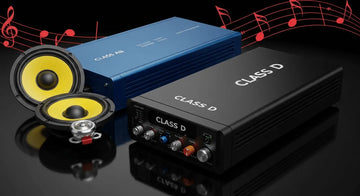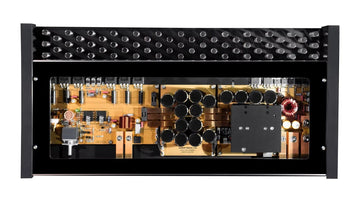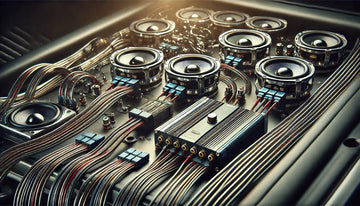5 Channel Amplifiers
Featured Products
Arc Audio X2 1100.5 Multi Channel Amplifier - Previous demo unit
Wavtech link1000.5plus 5 Channel Amplifier
All products loaded
The Ultimate Comparison: Choosing the Right 5 Channel Amp for Your Car Audio

For serious car audio enthusiasts, a factory sound system is merely a foundation. Building a truly immersive setup requires upgrading speakers, adding a subwoofer, and, most importantly, providing clean, ample power. This is the role of an amplifier, and for those seeking an ideal balance of simplicity, power, and performance, the 5 channel amp is a leading all-in-one solution. It eliminates the complexity of running multiple amplifiers, saving space, installation time, and money.
A single 5-channel amplifier is engineered to power your entire system: your front and rear speakers, plus a dedicated subwoofer. This integrated approach is more efficient than managing a 4-channel amp for your speakers and a separate monoblock for your bass. This guide is for the audio enthusiast who understands the basics but needs a clear path through technical specifications and marketing jargon. We will examine power ratings, sound quality metrics, and key features to help you compare options and find the ideal 5 channel amp for your vehicle, system, and budget.
Understanding What a 5 Channel Amp Is and How It Works
At its core, a 5-channel amplifier combines five distinct amplification channels within a single chassis. Four of these channels are typically identical, designed to power your four main speakers (front left/right and rear left/right) with full-range sound. The fifth channel is a dedicated, higher-power monoblock (single channel) specifically engineered to drive a subwoofer. This component is also sometimes called a 5 way amp, which is another term for the same versatile device. This design provides a complete power solution for the most common aftermarket car audio configuration in one convenient unit.
The advantages of this all-in-one approach are significant. First, it conserves space and simplifies wiring. Instead of finding room for two separate amplifiers and running two sets of heavy-gauge power and ground wires, you only need to mount and wire a single component. This is a major benefit in modern vehicles where space is often limited. Second, system integration and tuning become much easier. With all gain controls and crossovers housed in one location, you can dial in a cohesive, balanced soundstage without switching between different components. This unified control panel is key to ensuring your speakers and subwoofer work together harmoniously.
Finally, a 5-channel amp is often more cost-effective. Purchasing one quality multi-channel amplifier is usually less expensive than buying a separate 4-channel amp and a monoblock of comparable quality. Internally, these amplifiers frequently feature a hybrid design. Many use a Class A/B architecture for the four main channels, valued for its warm and accurate sound reproduction, paired with a highly efficient Class D architecture for the power-hungry subwoofer channel. Increasingly, full Class D models are becoming popular, offering excellent power, a compact footprint, and minimal heat generation across all five channels.
Key Factors for Comparing 5 Channel Amps
When you start shopping, you will face a wall of technical specifications. Understanding what they mean is crucial to making an informed choice. Do not be swayed by large "peak power" numbers; instead, focus on the metrics that translate to clean, reliable performance.
-
Power Output (RMS vs. Peak): This is the most important specification. Ignore "Peak" or "Max" power—it is a misleading marketing figure representing a brief, unsustainable burst. The only number that matters is RMS (Root Mean Square) power, which indicates the continuous, real-world power the amplifier can deliver. Your goal is to match the amp's RMS output to the RMS power handling ratings of your speakers and subwoofer. For example, an amp rated at 4 x 75W + 1 x 500W RMS is an excellent match for speakers that handle 75W RMS and a subwoofer that handles 500W RMS. Supplying speakers with clean RMS power within their limits provides loud, clear audio without distortion or damage.
-
Sound Quality Metrics: Two key figures reveal a lot about an amplifier's fidelity. Total Harmonic Distortion (THD) measures the amount of unwanted distortion the amp introduces to the signal. A lower number is always better; look for figures under 0.1% for high-quality sound. The Signal-to-Noise Ratio (SNR) measures the level of the audio signal relative to the level of background hiss and noise. A higher number is better, as it means you will hear more music and less electronic noise. An SNR above 95 dB is considered very good.
-
Built-in Features and Controls: A good 5-channel amp provides the tools to properly tune your system. Crossovers are essential; a High-Pass Filter (HPF) on the main channels prevents them from trying to reproduce deep bass they are not designed for, while a Low-Pass Filter (LPF) on the subwoofer channel ensures it only plays low-frequency notes. Gain control is used to match the amplifier's input to your head unit's output voltage—it is not a volume knob. Proper gain setting is critical for maximizing performance and preventing distortion. Many amps also include a convenient remote subwoofer level control, allowing you to adjust bass intensity from the driver's seat.
-
Amplifier Class and Efficiency: As mentioned, many 5-channel amps are hybrid Class A/B + D. However, modern full Class D amps have made significant strides in sound quality and offer the best efficiency. Higher efficiency means the amp draws less current from your vehicle's electrical system and generates less heat, making it easier to install in tight spaces.
Top 5 Channel Amps: A Detailed Comparison for Every Budget
The market for 5-channel amplifiers is diverse, with options ranging from budget-friendly powerhouses to high-fidelity audiophile components. To help you navigate the choices, we have organized our recommendations into three tiers. Finding the right balance between price and performance is key, and even a reliable cheap 5 channel amp can deliver a massive upgrade over a factory system if chosen wisely.
Premium Tier (The Audiophile's Choice)
Example: JL Audio XD700/5v2
This tier is for the enthusiast who prioritizes sound quality above all else. JL Audio's NexD™ switching technology delivers exceptional fidelity and efficiency in a compact chassis.
-
Power (RMS): 75W x 4 + 300W x 1 @ 2 ohms
-
Key Features: Studio-grade signal processing, flexible crossovers, and a compact footprint.
-
Pros: Superb sound quality, excellent build, very efficient.
-
Cons: Premium price point.
Mid-Range Tier (The Enthusiast's Sweet Spot)
Example: Rockford Fosgate P1000X5
This tier offers an excellent balance of robust power, great features, and proven reliability. Rockford Fosgate is a legendary brand in car audio for good reason.
-
Power (RMS): 75W x 4 + 500W x 1 @ 2 ohms
-
Key Features: C.L.E.A.N. setup technology for easy gain setting, remote punch level control, and robust power delivery.
-
Pros: Great power for the price, very reliable, easy to set up.
-
Cons: Larger physical size than some Class D competitors.
Budget-Friendly Tier (The Smart Upgrade)
When searching for a cheap 5 channel amp, it is crucial to focus on brands known for delivering honest power ratings. These amplifiers offer excellent value and serve as a perfect entry point for serious system upgrades.
Example: Skar Audio RP-350.5
Skar Audio has built a reputation for providing impressive power at an accessible price. It is a no-frills workhorse designed to get the job done.
-
Power (RMS): 50W x 4 + 350W x 1 @ 2 ohms
-
Key Features: MOSFET power supply, 4-way protection circuitry, remote sub control included.
-
Pros: Excellent value, strong subwoofer channel, compact design.
-
Cons: Sound quality metrics (THD, SNR) may not be as pristine as premium models.
Comparison at a Glance
Model Power Output (RMS @ 2Ω) Amplifier Class Key Features Price Range JL Audio XD700/5v2 75W x 4 + 300W x 1 Full-Range Class D NexD™ Switching, Advanced Crossovers $$$ Rockford Fosgate P1000X5 75W x 4 + 500W x 1 Class A/B + Class D C.L.E.A.N. Setup, Remote Control $$ Skar Audio RP-350.5 50W x 4 + 350W x 1 Class A/B + Class D 4-Way Protection, Compact Size $
Installation and Optimization Tips for Your 5 Channel Amp
Selecting the right amp is only half the battle; proper installation and tuning unlock its true potential. A rushed or incorrect installation can cause poor sound, electrical noise, or even damage to your new equipment. Following best practices will ensure your system sounds great and operates safely for years to come.
Before you begin, gather your tools and plan the layout. You will need a quality amplifier wiring kit with the correct gauge of power and ground wire for your amp's current draw. Do not skimp on this—using undersized wire is a fire hazard. Plan a mounting location that provides adequate ventilation to keep the amplifier cool. Under a seat or on a custom amp rack in the trunk are common choices. When running wires, always route the power cable on the opposite side of the vehicle from the RCA signal cables to prevent alternator whine and other induced noise. The ground connection is the most critical. Find a solid point on the vehicle's chassis, sand the paint down to bare metal, and use a secure terminal to create a short, solid ground connection. A poor ground is the source of most amplifier problems.
Once wired, it is time to tune the system. The most crucial step is setting the gains correctly. Start with the gains turned all the way down. Set your head unit's volume to about 75% of its maximum. While playing a test tone (e.g., 1000Hz for speakers, 50Hz for the sub), slowly turn up the gain for one set of channels until you hear audible distortion, then back it off slightly. Repeat this process for the other channels. This method ensures you get maximum clean volume without clipping the signal. Next, set your crossovers. A good starting point is to set the High-Pass Filter (HPF) for your front and rear speakers to around 80Hz. Then, set the Low-Pass Filter (LPF) for your subwoofer to the same 80Hz point. This creates a smooth blend where your speakers and subwoofer hand off frequencies without overlap or gaps. From there, fine-tune the settings to match your specific speakers and personal taste.
Making Your Final Decision: Which 5 Channel Amp is Right for You?
Choosing the perfect 5 channel amp comes down to a careful evaluation of your specific needs, system goals, and budget. There is no single "best" amplifier for everyone, but there is an ideal amplifier for you. By recapping the critical factors, you can establish a clear decision-making framework that leads you to the right component for your car audio build.
First, consider your speakers and subwoofer. Their RMS power handling ratings are your guide. Select an amplifier that provides power at or slightly below those ratings. Underpowering is safer than overpowering, but a close match will yield the best performance. Second, be realistic about your budget and sound quality expectations. If you are an audiophile chasing the purest sound, investing in a premium model with a low THD and high SNR is money well spent. However, if you are looking for a significant upgrade from stock without breaking the bank, a reliable cheap 5 channel amp from a reputable budget brand can provide the necessary power and impact at a more accessible price point. Finally, consider logistics. Measure the available space in your vehicle. If you have a compact car or want a stealth installation, a modern, efficient full Class D 5 way amp will be your best choice due to its small size and low heat output.
Here’s a simple framework:
-
If budget is your primary concern: Focus on RMS power per dollar from respected value brands.
-
If sound quality is paramount: Prioritize amps with excellent THD and SNR specs from brands like JL Audio, Audison, or Hertz.
-
If space is tight: Look exclusively at compact, full-range Class D amplifiers.
Installing an amplifier can be a rewarding DIY project, but if you feel unsure about wiring, gain setting, or tuning, do not hesitate to consult a professional installer. Their expertise can save you time and protect your investment. Ultimately, adding a quality 5-channel amplifier is one of the most transformative upgrades you can make to your car audio system. It is the heart of your setup, providing the life, clarity, and power that turns every drive into an immersive listening experience.
Related Collections
5 Channel Amplifiers
Frequently Asked Questions
Related Articles

Class AB vs Class D Amplifiers: Which One Should You Choose?

The Best Class A Amplifier: Key Features and Benefits Explained

Class A Car Amplifiers: The Gold Standard in Sound Quality






